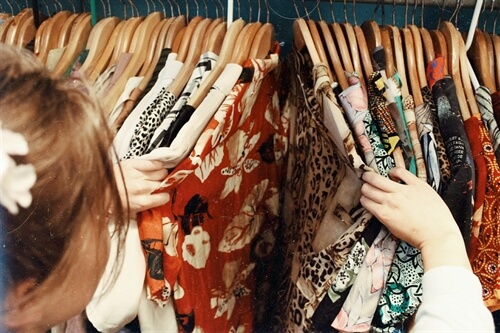Vintage garments, often unique and sometimes a little fragile, need special treatment during washing and wearing so that they can be enjoyed, admired and utilised by future generations. But vintage and retro clothing also merits extra care in storage, too. Here are some tips to help with getting your pre-owned clothing and accessories prepped for storage.
How long are you planning to store your vintage clothes?
Of course some of this advice can be applied to short-term storage, as well as long-term storage of vintage outfits. So it’s worth considering how you put retro clothes away in your wardrobe; as well as how you store out-of-season vintage clothes.
If you’re storing your clothes for more than a few weeks, climate-controlled storage is your friend. To keep vintage clothing in ready-to-wear condition you’ll want a well-ventilated, dry setting that has a consistent temperature and low light levels. This is difficult to achieve at home, however, and impossible to achieve in an attic, uninsulated loft or outbuilding. Warm environments (like an attic in the summer) will set stains and deteriorate elastic; while damp environments (like basements and outbuildings) will encourage mould to grow on your vintage clothes.
So it’s worth putting your vintage wardrobe into a climate-controlled storage unit.
Store clothing that is clean and dry
It’s really important to ensure clothes are clean and dry before you store them. Untreated stains can set, or even cause fabric to deteriorate. Damp will encourage mould and mildew. But frequent washing is hard on fabrics; so many vintage clothing fans prefer to spot clean and air their garments. It’s a judgement call that you’ll have to make on a case-by-case basis. If in doubt get professional advice on cleaning your vintage clothes for storage.
Another risk for vintage clothing is moth. Check that all your clothing is moth-free before storing; and use moth traps wherever you store vintage garments. This will alert you to any infestations so you can treat your clothes for moth before they get damaged.
How to hang vintage clothing
Metal wire hangers are universally reviled in the vintage clothing community. The metal may react with fabrics, and narrow wire hangers are guaranteed to pull your clothes out of shape. Padded hangers are recommended for vintage clothing. Use breathable garment covers for your vintage wardrobe. This will keep the dust off your clothes, and protect sequinned garments (for example) from snagging.
Do you have to insure your vintage goods in storage?
Public storage units mostly require you to insure your stored domestic goods – including vintage clothing. They might sneakily include the insurance premium in your monthly storage bill, so always ask for a breakdown when you get quotes for self-storage. If the insurance seems expensive, get a quick quote from us to see if we can do you a better deal on your self-storage insurance.
More ideas for storing vintage clothing and heirloom textiles
We have a blogpost about storing heirloom textiles, including vintage clothing. And we have some information about storing wedding dresses and putting handbags into storage. You may also find useful our tips for storing footwear.
And here is an external blogpost about storage written by a passionate vintage clothing fan!





